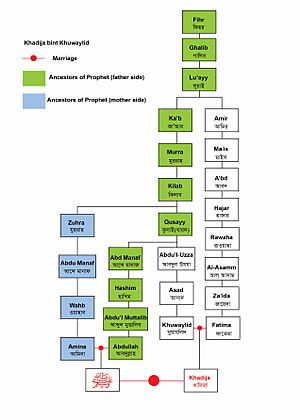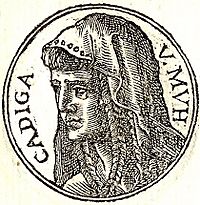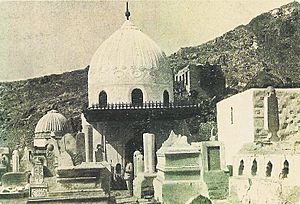Khadija bint Khuwaylid facts for kids
Khadijah bint Khuwaylid (born around 555 CE – died November 619 CE) was the first wife of the Prophet Muhammad and the first person to accept Islam. She was the daughter of Khuwaylid ibn Asad, a respected leader and successful businesswoman from the Quraysh tribe in Mecca.
Muslims often call Khadijah "The Mother of Believers" because of her important role in early Islam. She is also considered one of the four greatest women in Islam, alongside Asiya, Maryam, and her daughter Fatimah. Muhammad was married only to Khadijah for 25 years.
Quick facts for kids
Khadijah bint Khuwaylid
Mother of the Believers |
|
|---|---|
| خَدِيجَة بِنْت خُوَيْلِد | |
| Born | c. 555 or 567 |
| Died | 10 Ramadan BH 3 c. 619 (aged 63–64) Mecca, Hejaz
|
| Resting place | Jannat al-Mu'alla, Mecca |
| Other names | Khadīja al-Kubra |
| Known for | First wife of Muhammad |
| Title |
|
| Spouse(s) |
|
| Children | Sons:
Daughters:
|
| Parents |
|
| Relatives | Grandsons:
Granddaughters:
Cousin:
|
| Family | Banu Asad (by birth) Ahl al-Bayt (by marriage) |
Contents
Khadijah's Family and Background
Khadijah's mother, Fatima bint Za'idah, passed away in 575 CE. Her father, Khuwaylid ibn Asad, was a successful merchant and a respected leader. Some stories say he died around 585 CE, while others suggest he was still alive when Khadijah married Muhammad.
Khadijah's Business Success
Khadijah was a very successful businesswoman. She managed large trade caravans that traveled to places like Syria and Yemen. Her caravans were said to be as large as all the other traders' caravans in Mecca combined. People gave her many honorable titles, such as 'The Pious One', 'Princess of Quraysh' (Ameerat-Quraysh), and 'Khadijah the Great' (Khadija al-Kubra).
She was known for her kindness and generosity. She helped the poor, supported her relatives financially, and even helped poor family members get married. It is also said that Khadijah did not worship idols, which was unusual for people in Arabia before Islam.
Khadijah did not travel with her trade caravans herself. Instead, she hired others to manage the trading for her. In 595 CE, she needed someone to lead a trade trip to Syria. She hired Muhammad, who was 25 years old at the time. She offered him double her usual payment. Muhammad traveled to Syria with one of Khadijah's servants, Maysarah.
When they returned, Maysarah told Khadijah how honestly and honorably Muhammad had conducted the business. Muhammad brought back twice as much profit as Khadijah expected. Because of his honesty, Muhammad earned the titles al-Sadiq ('the Truthful') and al-Amin ('the Trustworthy').
Khadijah's Previous Marriages
Before marrying Muhammad, Khadijah had been married twice. She had children from these earlier marriages. After her second husband passed away, she became a widow.
Marriage to Muhammad
Khadijah was very impressed by Muhammad's honesty and good character. She sent a friend, Nafisa, to ask Muhammad if he would consider marrying her. Muhammad hesitated because he did not have much money. Nafisa then asked if he would consider marrying a woman who could support herself. Muhammad agreed to meet with Khadijah.
After their meeting, they spoke with their uncles. Both families agreed to the marriage. Muhammad's uncles then formally proposed to Khadijah. Her uncle accepted the proposal, and they were married. At the time, Muhammad was around 23 to 25 years old. Some sources say Khadijah was 40, while others suggest she was about 28 or 30.
Children of Khadijah and Muhammad
Muhammad and Khadijah had six children together. Their first son was Qasim, who passed away when he was young. Their second son was Abd Allah, who also died in childhood.
They had four daughters:
- Zaynab (born around 599 CE)
- Ruqayyah (born around 601 CE)
- Umm Kulthum (born around 603 CE)
- Fatimah (born around 605 CE)
Two other children also lived in Khadijah's home: Ali ibn Abi Talib, who was Muhammad's cousin, and Zayd ibn Harithah, a boy who had been kidnapped and sold into slavery. Zayd was a slave in Khadijah's household for several years. When his father came to Mecca to take him home, Muhammad insisted that Zayd be given a choice. Zayd chose to stay, and Muhammad adopted him as his own son.
Khadijah Becomes the First Muslim
According to Islamic tradition, when Muhammad received his first revelation from the Angel Gabriel, he was very scared. He returned home to Khadijah, asking her to cover him with a blanket. After he calmed down, he described what happened. Khadijah comforted him, assuring him that Allah would protect him and would never let anyone harm him because he was a man of peace and kindness.
Khadijah was the very first person to believe in Muhammad's message and accept Islam. Her cousin, Waraqah ibn Nawfal, also confirmed Muhammad's prophethood soon after.
Khadijah strongly supported Muhammad's mission as a prophet. She always helped him, spread his message, and stood against those who opposed him. Her encouragement helped Muhammad believe in his mission and share Islam with others. Khadijah also used her wealth to support the new Muslim community. When the polytheists (people who worshipped many gods) and leaders of the Quraysh tribe harassed the Muslims, she used her money to free Muslim slaves and provide food for the community.
In 616 CE, the Quraysh tribe declared a trade boycott against Muhammad's clan, the Hashim clan. They attacked, imprisoned, and beat Muslims, who sometimes went for days without food or water. Khadijah continued to support the community until the boycott was lifted in late 619 CE or early 620 CE.
Khadijah's Passing
Khadijah passed away in November 619 CE. Muhammad later called this year the 'Year of Sorrow' because his uncle and protector, Abu Talib, also died around the same time. Khadijah is believed to have been about 65 years old when she died. She was buried in the Jannat al-Mu'alla cemetery in Mecca, Saudi Arabia.
In the years after Khadijah's death, Muhammad faced more challenges and persecution from those who opposed his message. He eventually migrated from Mecca to Yathrib (which later became Medina) after Khadijah's passing.
Khadijah's Children and Relatives
Sons
- Qasim ibn Muhammad: Died in 601 CE, after his third birthday.
- Abd-Allah ibn Muhammad: Died in childhood in 615 CE.
Daughters
- Fatimah (605–632 CE): She was known as 'The mother of her father' because she cared for Muhammad after her mother died. She married Ali, who later became the fourth caliph. All of Muhammad's surviving descendants come through Fatimah's children. Muhammad deeply loved her two sons, Hassan and Husayn.
- Zaynab (599–629 CE): She married her cousin Abu al-As. Her husband accepted Islam before her death.
- Ruqayyah (601–624 CE): She first married Utbah ibn Abi Lahab and then married Uthman, who later became the third caliph.
- Umm Kulthum (603–630 CE): She first married Utaybah bin Abi Lahab. After her sister Ruqayyah died, she also married Uthman. She did not have any children.
Cousins
- Waraqah ibn Nawfal: He was a cousin of Khadijah. He had converted to Christianity before Muhammad's revelations. Waraqah is important because he confirmed Muhammad's prophethood, saying that Muhammad had received the same divine law that came to Moses.
Images for kids
See also
 In Spanish: Jadiya para niños
In Spanish: Jadiya para niños





